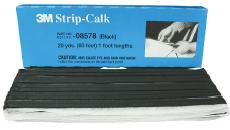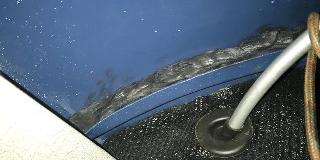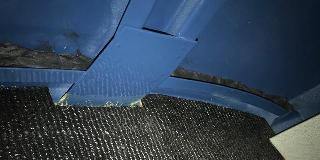The MGA With An Attitude
SEALING The BULKHEADS -- BD-109
The main concern with sealing the bulkheads is to stop air intrusion into the cockpit, mostly from the front. You want to prevent engine fumes from passing through the front bulkhead. You want to exclude hot air from the engine compartment in warm weather, and cold air intrusion in cold weather.
The first order of business is to assure that all of the holes in the front bulkhead are sealed with rubber plugs or pass-through grommets. The best approach to this is to work after dark or in a dark garage. Place a bright light in the engine compartment, then look under the dash to see where any light might be showing through holes in the firewall. Replace any missing grommets and hole plugs. A dab of caulking may suffice for smaller unused screw holes. Keep up the good work until there is no more light showing through.
There will be a small gap between the firewall and the top body cowl. This is a fairly close fitting joint but was never welded. This joint originally had a felt seal strip, but this is commonly lost during the restoration process. If you can see light shining through this joint, feel free to use some caulking on the passenger compartment side where it would be least visible. Easy to caulk here if
 you can do it during restoration when the body is bare and perhaps still in primer paint. If sealed after painting is complete, you might like to paint over the caulking. Otherwise not to worry about appearnace, as no one wil ever see this joint once the car is completely assembled. If ths joint is to be sealed after assembly, then something like 3M Strip-Caulk may work well.
you can do it during restoration when the body is bare and perhaps still in primer paint. If sealed after painting is complete, you might like to paint over the caulking. Otherwise not to worry about appearnace, as no one wil ever see this joint once the car is completely assembled. If ths joint is to be sealed after assembly, then something like 3M Strip-Caulk may work well.


The next place for a major air leak can be less obvious and can cause a very substantial cold draft in the winter. The breeze enters through the access holes used to wrench the bolts which secure the windscreen frame at the body sides. From there it rises to spill over the top of the kick panels ahead of the doors. The solution is to remove the forward kick panels and install cheap plastic snap plugs (local hardware store parts) in the two holes on each side, forward of the door. This may be the ultimate trick for keeping you cozy in cold weather.
Sealing of the rear bulkhead is much less significant, maybe not even important. In fact you might prefer to leave it unsealed to allow some air flow from the passenger compartment into the boot. There should be in place the (front) spare tire cover, the rubber seals around the boot lid and fuel filler pipe, and the seal between the back of the boot floor and the rear body cowl. All of this should limit air flow through the rear bulkhead to a minimum, generally equal to any air which may escape past the boot lid seal. This small air flow may be beneficial to keep the boot aired out and dry if the boot lid seal leaks to allow water in (which is not particularly uncommon). There is a significant gap between the top of the rear bulkhead and the rear body cowl, which was never sealed from the factory.
|


